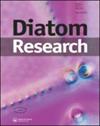使用更新的细粒度分类学对南极洲维斯特福尔德山湖泊沉积物硅藻的重新调查
IF 1.3
3区 生物学
Q2 MARINE & FRESHWATER BIOLOGY
引用次数: 1
摘要
南极大陆的非海洋硅藻区系目前正在进行修订,因为最近在海洋和亚南极区域开展的工作揭示了一些新的特有物种。地方性物种报告不足的部分原因是历史上南极物种与欧洲物种名称的“强制匹配”。在南极洲东部,Vestfold Hills是一个被广泛研究的地区,以其跨越盐度梯度的湖泊多样性而闻名,Roberts和McMinn(1999)对南极洲Vestfold Hills盐湖的硅藻进行了20多年的主要鉴定资源。为了确定提高的分类学分辨率是否会改变这些湖泊的生态解释,Roberts和McMinn(1999)首先检查了30个准备好的湖泊沉积物样本,使用更新的细粒度分类学方法重新分析。我们的分析证实了盐度和碱度在Vestfold Hills硅藻群落结构中的作用。因此,分类学分辨率的提高并没有改变原有的生态学解释。然而,Vestfold Hills的修订植物区系有37种南极地区特有的物种,包括Luticola, Sabbea和Halamphora等成员。与文献中报道的67个分类群相比,共观察到38属183个分类群。修订后的植物区系,包括更大比例的特有物种,可能会提高我们对一般硅藻群落的了解,并对南极洲的保护和生物多样性估计具有更广泛的影响。这些数据如果得到更广泛的应用,就可以纳入更大规模的南极微生物生物地理学和生物多样性研究。本文章由计算机程序翻译,如有差异,请以英文原文为准。
A re-investigation of lake sediment diatoms from the Vestfold Hills, Antarctica, using an updated, fine-grained taxonomy
The non-marine diatom flora of the Antarctic continent is currently being revised as recent work within the Maritime and Sub-Antarctic regions has unveiled a number of new endemic species. The under reporting of endemic species is partially due to the historic ‘force-fitting’ of Antarctic species into European names. Within East Antarctica, the Vestfold Hills are an extensively studied area known for their diversity of lakes spanning a salinity gradient, for which Diatoms of the saline lakes of the Vestfold Hills, Antarctica by Roberts & McMinn (1999) has a primary identification resource for over two decades. To determine if improved taxonomic resolution alters the ecological interpretation of these lakes, 30 prepared lake sediment samples first examined by Roberts & McMinn (1999) were re-analysed using an updated, fine-grained taxonomic approach. Our analyses confirmed the role of salinity and alkalinity in structuring Vestfold Hills diatom communities. Thus, the increased taxonomic resolution did not change the original ecological interpretation. However, the revised flora of the Vestfold Hills features 37 species endemic to the Antarctic Region, including members of Luticola, Sabbea and Halamphora, among others. In total, 183 taxa across 38 genera were observed, in contrast to the 67 taxa reported in the original work. The revised flora, including a larger proportion of endemic species, may improve our understanding of the diatom community in general and has wider implications for both conservation and biodiversity estimates of Antarctica. More widely applied, these data can be incorporated into larger studies of Antarctic microbial biogeography and biodiversity.
求助全文
通过发布文献求助,成功后即可免费获取论文全文。
去求助
来源期刊

Diatom Research
生物-海洋与淡水生物学
CiteScore
2.70
自引率
16.70%
发文量
27
审稿时长
>12 weeks
期刊介绍:
Diatom Research is the journal of the International Society for Diatom Research. The journal is published quarterly, in March, June, September and December, and welcomes manuscripts on any aspect of diatom biology.
In addition to full-length papers, short notes and reviews of recent literature are published which need not contain all the sections required for full-length papers; we see these as being necessary to record information which is of interest but which cannot be followed up in detail. Discursive “Opinion” papers are encouraged which would not necessarily follow the normal lay-out. If extremely long papers are to be offered, the author(s) should contact the editors first to discuss any problems. Book reviews, obituaries and meeting reports can be published. All papers will be subject to critical review by the editors and referees, as appropriate to their content. Papers will be accepted in English only.
 求助内容:
求助内容: 应助结果提醒方式:
应助结果提醒方式:


